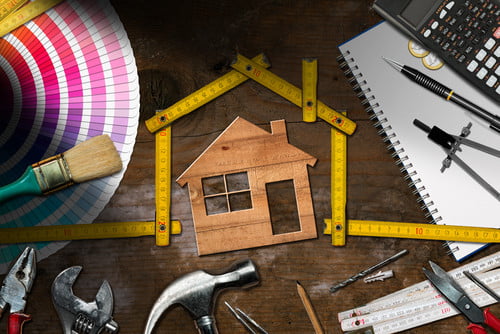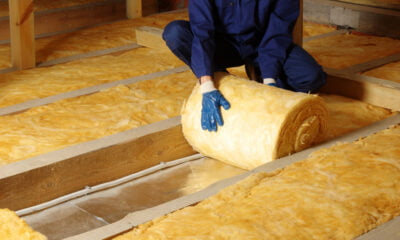

Environment
5 Ways To Make Sure Your DIY Project Is Good For The Environment
When it comes time to remodel part of your home, create new furniture, or even add a deck or other features, doing it yourself brings a certain amount of satisfaction. It makes your project more personal and gives you a great deal of control over how things are done.
This is actually a great opportunity. Home construction and remodeling projects can have a huge impact on the environment. Contractors like to get jobs done quickly, and their focus is often on cutting expenses so they can offer you the most competitive quote. However, doing things quickly often results in a waste of materials, using less sustainable replacements, and even releasing harmful toxins into the air.
Doing it yourself gives you an opportunity to avoid all that while saving some serious cash too. Here are five ways you can make sure your DIY project is not harming the environment.
Deconstruction vs. Demolition
What deconstruction means in its simplest form is that you take things apart rather than take a sledgehammer to them. So, if you are removing a wall, instead of a sledgehammer, you would use other tools to remove drywall, old wiring and electrical boxes, switches, and even the wood and insulation inside the wall.
This has a couple of benefits, and it also offers you some protection. If you are in an older home, there is a risk of asbestos exposure when doing demolition, and you may not know it until it is too late. You may think that most homes and offices have already been rid of asbestos, but studies show that it is still a risk. Some states require an asbestos inspection, and be sure you are removing it in compliance with your local laws, but deconstruction is a much safer route than demolition.
The other advantage to deconstruction? Many of the materials used in your walls, like copper wiring and switch and electrical boxes can be recycled. In some areas, recyclers will pay you well for these materials, giving you more money to put towards your project.
Refresh and Reuse
Refreshing and reusing is not just related to deconstruction. Besides recycling materials, in some cases you can reuse them in your current project or a future one. However, this is not just true of large projects like remodels.
If you are craving a new look for your furniture, consider refinishing it or reupholstering it in new fabric. You may even be able to use the old fabric for another project. Furniture can be made from pallets, old wood, and other items you may have around the house. A refresh of paint or repurposing only makes sense.
Old barn wood makes great art to hang on your walls. So do old signs, metalwork, driftwood, and other items you might otherwise recycle, donate, or even throw away. If you can refresh or reuse old items, repurpose others, and get rid of as little as possible, your project will have a much smaller impact on the environment.
Choose Sustainable Materials
For things you must replace, use sustainable materials like bamboo, hemp, and others. In some cases, these materials might cost more, but they also last longer.
For instance, when choosing flooring or decking materials, bamboo is a much more durable choice, and often you can find 100 percent recycled bamboo to use. Most the commercially available types are strand-woven, which means that decks will last many years longer than when built with traditional decking materials.
Of course, bamboo is not the only choice out there. Composite decking is also very durable, and much better than using traditional timber. The deck is also not the only place where sustainable materials can be used. Furniture, curtains, pillows, flooring, and more can all be made from recycled and sustainable materials. Even kitchen counters can be environmentally friendly and responsibly sourced. No matter what room in your home you are remodeling or if the job is big or small, you have eco-friendly choices.
Embrace Efficiency
Old appliances have a certain charm, but in many cases replacing them with more efficient, modern styles is a much better idea. The reason is simple: more efficient appliances are better for the environment. Here are some things to look at when doing your DIY project:
- Hot water: On-demand hot water systems are much more efficient than tank-style systems, and they tend to last longer.
- The kitchen: The stove, the microwave, and your refrigerator can be much more efficient, using up to 30% less power than older models. Dishwashers can be more efficient as well, and when used properly can actually create less environmental impact than washing dishes by hand.
- The bathroom: Having a more efficient bathroom is both easy and relatively inexpensive. Low flow faucets, toilets, and shower heads, as well as adding an aerator to the faucet can all save water and energy.
- The HVAC system: That old heating and cooling unit could be costing you and the environment a lot. Not only are old systems more prone to leaks and other issues, but they use more energy — a lot more. While you may not be able to do this yourself, it still may be part of a larger remodeling project.
- Windows: replacing single pane glass with double paned windows and making sure they are properly sealed can make a huge difference in how much heating and cooling you are wasting.
The point here is to be as efficient as you possibly can in every area of any DIY project. Of course, if you are replacing appliances, contact a local company who responsibly recycles them to get rid of these items rather than just throwing them out.
Go Green
One of the biggest DIY trends is green energy. When doing certain projects, like adding a workshop or a garage, it is a good time to add a sustainable energy source like wind, solar, or a combination of both depending on where you live. With the rising popularity of electric vehicles, solar charging stations are becoming a more common home addition.
There are even advances coming like solar shingles instead of large solar panels, and the cost is not much higher than traditional roofing. Installation is very similar as well, and many experienced DIY individuals can manage these projects on their own or with minimal professional help.
DIY projects can be very satisfying, from a complete home remodel to simple projects. Just be sure before you jump in and during the process that you are working in a way that is good for the environment as well.


 Features9 months ago
Features9 months agoWhat is the Eco-Friendliest Option to Wash Your Dishes?

 Environment12 months ago
Environment12 months agoBuilding a Career in Green Construction: Tips and Insights

 News11 months ago
News11 months ago5 Ways Fleet Maintenance Software Can Help Businesses Be More Eco-Friendly

 Features10 months ago
Features10 months agoAddressing Pressing Ethical Concerns with Crypto Exchanges





























